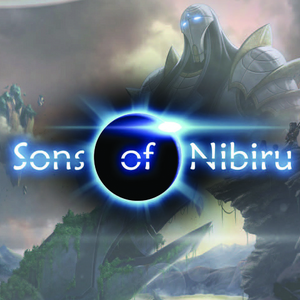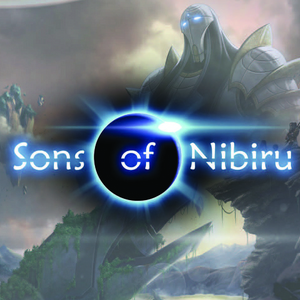It was around 15,000 BC when a faraway alien race grew interested in this strange planet called Earth. While the dominant species of Earth were primitive, the diversity of life inhabiting this biosphere, even among humanoids, proved too enticing for the extraterrestrials to ignore.
On their home world of Nibiru, locked in a wide elliptical orbit about the Sirius star system, there were only three distinct species. Each had been forced to evolve in order to survive the harsh cycles of the tidal-locked planet.
There were three stars within the Sirius system. Sirius A and Sirius B were binary and rotated around each other. The third, Sirius C, was a rogue star and completed its orbit once every 189 years. With each passage through Nibiru’s path, the star would heat up the atmosphere to a boiling, uninhabitable 914 degrees Fahrenheit, incinerating every living creature on the planet’s surface.
Nibiru was a doomed world, one of unending fire and unyielding frost—a perpetual cycle resulting in calamitous surface conditions that slowly formed after every pass and lasted for over a century.
The species had a rapid evolution, one born of necessity. On Nibiru, biological flesh was nothing more than a weakness, an evolutionary liability. As a means to combat such extreme planetary conditions, the Ancients who inhabited the planet evolved to be entirely elemental. But it was this evolution that ultimately led to their doom.
In time, their civilization developed the mental capacity to understand, and soon master, space travel. In a frantic means for continued survival, they made various attempts to settle numerous planets similar to their own—Ewatne, Opheliae, Hydrux, and others.
But their elemental bodies proved unable to adapt to these planets’ native environments. Despite their extensive use of advanced technology, with each attempt, the colonizers would last no more than months on the alien terrain.
Faced with the impending certainty that the rogue star would one day soon traverse close enough to annihilate their world, the inhabitants of Nibiru collectively agreed to awaken an ancient deity—one who had slept for tens of thousands of years.
Nun, the Creator.
Many rumors abounded as to what transpired in those final days, and the truth had a strange way of morphing over the course of 8,611 light years. But whatever the impetus, Nun accepted the request of Nibiru’s inhabitants.
It was with a grave sense of import that he bid the planet farewell and fired up his ancient ship, which had remained entombed miles below the Nibirun crust, and headed to Earth to begin again.
To endure the thousands of years it would take to travel such a distance, Nun placed himself in stasis, resuming his slumber.
He reached his destination, a tiny blue marble adrift in a sea of nothingness, during the fourth millennium BC. The exact location of his arrival was unknown, but it was thought to be somewhere within the cradle of life—that vast expanse somewhere between Africa and the Middle East.
Nun’s ship was unlike any of the technology known even today. It was considered a Genesis-class ship, one imbued with the power to generate alterations within the very fabric of reality.
Upon impact, the ship triggered a tear in reality, suspending the craft within planet Earth but not quite on Earth itself.
The force of the crash caused the ship to burrow deep into the terrain, forming a vast crater that cradled the massive ship, sending its rear jutting high enough to rival the surrounding mountain peaks.
Nun awoke to the sound of the ship powering down and set about exploring the landscape of this new planet.
After he exited, he began to assess the damaged ship. The front was destroyed beyond repair. The rear—suspended from the crater. Waters used in the propulsion system began to seep out of the hull. Thick and almost gelatinous, those waters slowly oozed from the ship, forming the massive great lake, the Waters of Nun, in the surrounding crater. The waters swarmed the ship in a calm counterclockwise vortex that churned of its own volition.
Nun made his way to the highest cliff overlooking the landscape. It was from there that he assessed the situation. The surrounding terrain was wild but habitable. Its lush foliage and abundant waters differed vastly from the harsh, rocky terrain of Nibiru. He saw a mixture of jungles, mountains, and desert. It was almost incomprehensible, the diversity of this new land. Nun took it all in and nodded to himself. This would be the place.
Engulfing the entire landmass and faintly visible in the distance stood a large wall of black flames. Nun called this place the Rift, a void protected from the outside world—a sanctuary that protected the outside world from all contained within.
Nun’s first task was to create his Black Temple, a laboratory of sorts on the eastern side of the Rift. He decided upon osmium and iridium, elements that, while rare on Earth, were plentiful within the core of his ship.
Like a mad scientist, he toiled day and night inside the hulking pyramidal mass as he pondered how to replicate the Ancients in this new biome.
Using the elements of Earth, the mysterious crystals he’d gathered from Nibiru, and the waters from his ship to experiment with in his facility, Nun soon accomplished his task. The three races of Nibiru were replicated with modifications that enabled them to thrive in Earth’s biosphere.
The first race called themselves Titans. Massive in size, they possessed an unusual affinity to the elements. But their appearance more often resembled monstrous creatures than men.
The second race called themselves Deva, and they were exceptional warriors. The Deva created superior technology and weaponry that advanced their destructive purpose, but inner conflict and growing animosity began to corrupt their kin.
Lastly were the Anunnaki, who remained focused on the advancement of human culture, unlike the others. Possessing incredible control over energy conversion, the Anunnaki were able to harness these powers to become great developers of architecture and power arrays.
Still, hundreds of years would pass before the Ancients were allowed to leave the Rift. In the interim, they trained under the watchful eye of Nun. Through his tutelage and the use of his omniscience, these first earthly creations learned of the outside world.
Each race was entrusted with one final goal: once they acquired the necessary resources, they would aid their ancient predecessors on their home world—if they still existed.
When the time had come, Nun warned his creations that upon their exiting the Rift, they would never be able to return, for the black flames of the Rift would destroy all outside contamination and would disintegrate their being should they ever dare.
Accepting this fate, each race departed one by one to explore and eventually help build a greater society in the outside world.
It was predetermined that Nun could not venture forth with them. As an ancient being, he could only exist on the edge of reality.
Once the totality of his creation departed the Rift, Nun settled himself deep within his laboratory and resumed stasis.
That was one-thousand years ago. Nun was still in slumber but the black flames of the Rift grew restless. What does this disturbance mean, and what is Nun to do?












Comments (0)
See all